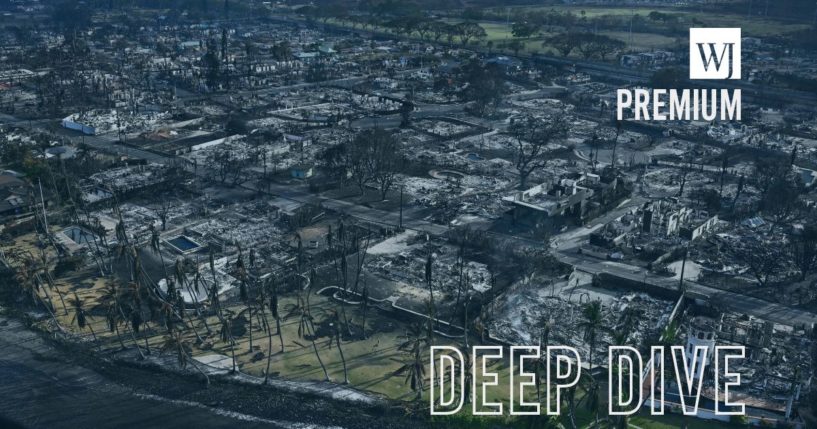
Gov't Incompetence? Lives Lost? Everything You Need to Know About the Maui Fire
The quaint and historic town of Lahaina, Hawaii, is known for many things: its whale-watching tours, its beautiful beaches, its iconic Front Street and much more.
But after disaster struck in early August, the old whaling village will likely be remembered most for just one thing.
Here is how one of the saddest tragedies in American history — the Maui fire — unfolded.
How the Fires Began
Although the investigation was ongoing in early September, Hawaiian Electric said that downed power lines, caused by high winds from the nearby Hurricane Dora, were likely the cause of the first blaze in Lahaina, according to The Maui Times.
Around 6:30 a.m. on Aug. 8, residents of Lahaina and other communities in West Maui reported power outages, according to an Associated Press timeline.
Resident Shane Treu reported seeing one power line fall over and ignite a grass fire, which quickly spread near the Lahaina Intermediate School.
The nearby neighborhood evacuated to a local civic center, and authorities declared the fire contained by 10 a.m., the AP said.
Around 3:30 p.m., the fire flared up again, and the flames soon spread to the downtown area as those nearby began fleeing.
Meanwhile, the fire department closed Lahaina Bypass, the only route south out of town.
Residents were not alerted by any of the town’s 80 warning sirens.
Although the Hawaii Emergency Management Agency did post an evacuation notice on social media, that was almost an hour-and-a-half after the flare-up, and many residents did not have cellular service or power.
Eventually, the flames reached Front Street, which borders the ocean.
The Roadblocks
Sadly, it was not just the flames that killed Maui residents, but incompetence.
Perhaps the most infamous of the roadblocks was on Front Street.
The police and fire departments had blocked the only road out of town to the south, forcing residents onto the grid-locked Front Street to the north, which was surrounded by flames and the ocean on one side.
Many residents burned alive in their cars or died from smoke inhalation, while others jumped the seawall and into the ocean.
WARNING: The following video shows an intense situation that some viewers may find disturbing.
@brigettefraser23 Credit to: @Eric & Lisa West #Lahaina #Maui #Hawaii ♬ original sound – Brigette Fraser
But many of the residents who survived did so because they ignored the blockades.
Maui resident Nate Baird and his family, for instance.
“Nobody realized how little time we really had,” Baird told the AP. “Like even us being from the heart of the fire, we did not comprehend. Like we literally had minutes and one wrong turn. We would all be dead right now.”
🚨Eric West, local resident of Lahaina, posted this a few days ago. Here, he interviews a guy everyone calls, “Fish” – a local legend know for his surfing and his handmade crafts – who witnessed first hand the cause of the ‘car blockade’ on Front Street.
Please share this… https://t.co/tb8og87cf6 pic.twitter.com/UKlQP6u29b
— GEORGE (@TheGeorgeHQ) August 16, 2023
Local and Federal Government Response
Infuriated Maui residents strongly criticized the local and federal government response to the fire.
When asked during an Aug. 16 news conference why none of Maui’s sirens — normally used for tsunamis — sounded during the blaze, Herman Andaya, administrator of the Maui County Emergency Management Agency, defended the agency’s decision.
“The public is trained to seek higher ground in the event that the siren is sounded. … Had we sounded the siren that night, we’re afraid that people would have gone mauka [to the mountainside], and if that was the case then they would have gone into the fire,” Andaya said.
Maui Emergency Management Agency Administrator Herman Andaya today defended the decision not to activate emergency sirens warning #Maui residents and visitors about the wildfires. Here’s a clip from the press conference.
Details: https://t.co/0m3zSd9QmD #HInews #StarAdvertiser pic.twitter.com/lSe3iM6flj
— Star-Advertiser (@StarAdvertiser) August 17, 2023
But Maui residents weren’t buying it. HEMA’s own website refers to the sirens as an “All-Hazard Statewide Outdoor Warning Siren System.”
A number of residents told Hawaii News Now that the sirens would have alerted people to look outside, see the fire and evacuate accordingly.
Andaya resigned shortly after the news conference.
Another area of criticism was the roadblocks.
Maui Police Chief John Pelletier defended them during a news conference a couple of weeks after the fire, the AP reported.
“We did not close or forbid people from getting out of Lahaina,” Pelletier said. “If there was a downed power line that was live, we wanted to make sure that you didn’t go over a downed live power line.”
Residents also were angry with Hawaii Gov. Josh Green over an emergency order the Democrat signed on July 17, about three weeks before the Lahaina fire.
The “Emergency Proclamation Relating to Housing” suspends a number of laws — including historic preservation, environmental review, open government and collective bargaining laws — all for the stated purpose of speeding up development and easing the state’s housing crisis, according to the Honolulu Civil Beat.
Green’s comments after the fire also raised concerns.
“I’m already thinking about ways for the state to acquire that land so that we can put it into workforce housing, to put it back into families or to make it open spaces in perpetuity as a memorial to people who were lost,” he told reporters on Aug. 15.
On Aug. 22, residents at a Maui council meeting vented their frustrations.
“The governor says, ‘Oh, I’m going to take the land.’ He’s talking about [how] the state wants to purchase all this land and come in and open it for the working class and also for a memorial and things like that. Who the hell does he think that he should get this land? This land belongs to the people already,” one resident said.
“I would just like to ask each council member to let me know, are you in favor of this emergency proclamation that takes away sunshine law, collective bargaining … all your power and decision-making?” another resident said.
“Who’s in favor of that because I have serious concerns.”
Hawaiians also have heavily criticized Maui Mayor Richard Bissen, saying he displayed a lack of leadership and accountability. Some have asked him to resign, Hawaii News Now reported.
At a news conference Tuesday, a reporter asked who was in charge of overseeing Maui Emergency Management during the fires.
“I’m not sure who was in charge. I think Herman Andaya was still in charge, he just wasn’t present. He was in contact with his team — I guess by phone? I don’t know exactly how, but he was still the emergency manager for us then,” Bissen said.
The mayor also has faced criticism for not disclosing where he was during the fire, Hawaii News Now reported. He addressed those concerns in a video statement Thursday.
“I want to be clear and repeat that I had been present in our emergency operating center since Aug. 7. Due to the impending weather report, we held a meeting in the emergency operation center on Monday, Aug. 7, and it was decided by MEMA that we should go to partial activation starting at 9 p.m. that evening,” Bissen said.
Maui residents — and many Republicans — have rebuked President Joe Biden’s response to the crisis as well.
While vacationing in Rehoboth Beach, Delaware, on Aug. 13, Biden was asked about the rising death count in the Lahaina fires. The president, who had not yet visited Lahaina, simply smiled and said “no comment.”
Nearly two weeks later, a White House spokeswoman told The New York Times that Biden “didn’t hear the question.”
The White House now claims Joe Biden ‘didn’t hear the question’ when he had ‘no comment’ on Maui.
Decide for yourself:https://t.co/WrX8qOyvhG pic.twitter.com/i6ZHfqU8Tl
— The First (@TheFirstonTV) August 25, 2023
Former President Donald Trump laid into Biden on Truth Social in a video message Aug. 14, calling his political rival’s response a “disgraceful thing.”
Statement from President Donald J. Trump on Devastating Maui Wildfires pic.twitter.com/ReHhmhfYj6
— Team Trump (Text TRUMP to 88022) (@TeamTrump) August 14, 2023
After declaring a federal disaster in Hawaii, Biden announced a one-time payment of $700 per household to residents affected by the fire. This seemingly stingy relief effort also attracted criticism.
2. We’re laser-focused on getting aid to survivors, including Critical Needs Assistance: a one-time $700 payment per household offering relief during an unimaginably difficult time.
We have staff on the ground dedicated to helping survivors navigate the registration process.
— President Biden (@POTUS) August 14, 2023
In an interview with reporter Jeremy Loffredo on social media, an anonymous Lahaina resident who lost her home in the fire said Biden should keep his money.
“I think Joe Biden should take his $700 and get back on the f***ing plane and go home. That’s what I think,” she said. “The $700 compared to all the millions he’s giving to Ukraine. Why? We need it.
“That’s why we don’t understand why. We’re citizens and we cannot get money, but if they’re not citizens, they get gazillions of dollars from the U.S.A. Where is our government?”
WARNING: The following video contains vulgar language that some viewers may find offensive.
An indigenous Lahaina local tells me she lost her house, pets, medicine and cash savings. She can’t get a call back from FEMA and has yet to see any type of US aid relief.
She says Joe Biden should keep his insulting $700 because of the “gazillions” he’s sending Ukraine. pic.twitter.com/FLNgMdemtq
— Jeremy Loffredo (@loffredojeremy) August 25, 2023
The Republican-led House Oversight and Accountability Committee announced Tuesday it is launching an investigation into the federal government’s handling of the crisis, the Honolulu Civil Beat reported.
Lahaina Today
Lahaina experienced the deadliest U.S. wildfire since 1918, according to the National Fire Protection Agency.
Hawaii News Now reported Sunday that the confirmed death toll stood at 115, where it had remained for about two weeks, with 58 of the victims identified.
That same report said the Lahaina fire was now 100 percent contained, with 2,170 acres affected by the blaze.
Before the FBI released an official list on Aug. 24, the number of missing people was thought to be about 1,000. The FBI list declared 388 people missing.
Unfortunately, the tragedy is not over yet. Residents worry that the crisis presents an irresistible opportunity for greedy land developers eager to capitalize on the situation, the AP reported. Many locals who are an integral part of what makes Lahaina Lahaina will be “priced out” of the neighborhood.
It’s a sad story with a grim reminder: What happened in Lahaina can happen anywhere. Should people trust their governments to respond any differently than they did in Maui?
Truth and Accuracy
We are committed to truth and accuracy in all of our journalism. Read our editorial standards.
Advertise with The Western Journal and reach millions of highly engaged readers, while supporting our work. Advertise Today.












